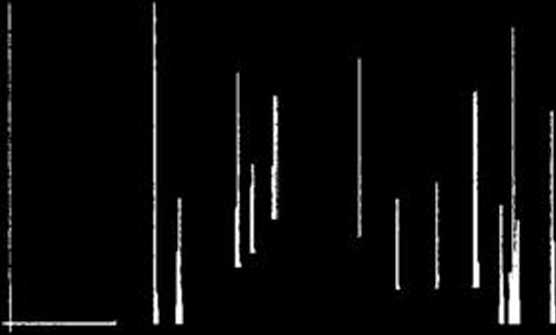117828245
Low-Temperature TLC-MS ol Essentiai Dis
200 400 600 800
(b)



Figurę 4
Densitogram (a), vkfeoacan (b) oMalned from the essentiai oll of S. trifoba, and mass spectra of separated chromatografie bands
rrtt
(1H5).
flcation of individual compounds was possible because of gas chromatographic separation of the sampies, use of a digital library of mass spectra, and comparison of the retention times of the separated essentiai oil components with those of the standard*.
With complex mbetures of compounds (for example essentiai oils), thin-layer chromatography can only provide group separation, i.e. fractionation into the less complex mixtures. This alter-native procedurę can, however, have very appreciable advan-tages if coupled with a well performing detection system. A mass spectrometer coupled with thin-layer chromatography via a TLC-MS interface can provide valuable analytical rcsults, as shown in this study.
Aftcr the Iow-temperaturę development of the chromatograms, the first step was to obtain the respective densitograms. Images of the chromatograms were also saved as videoscans. The wel) separated chromatographic bands then underwent mass spec-trometric anaJysis. The results obtained are presented in Figures 1-5. In these figures, multiple fingerprints are presented of the five sagę species, each composcd of the densitogram and four (S. lavandulifolia)t or five (Sstaminea, S. hi ans, S. triloba, and S. nemorosa) mass spectra of the respective frac-
274
Journal of Planar Chromatography 23 (2010) 4
Wyszukiwarka
Podobne podstrony:
Low Temperalure TLC-MS of Essentiai Oils 200
Low-Temperature TLC-MS of Essential Oils from Five Different Sagę (Sa/wa) Species Mieczysław Sajewlc
Low-Temperature TLC-MS of Essential Oils(1) 275 20)
Low-Temperature TLC—MS of Essential Oiis from the piąte before elution of the chromatographic bands
7 Low-Temperature Thin-Layer Chromatography with Mass Spectrometric Detection (LT TLC-MS) The result
Low Temperaturę Planar Chramatography-Densitometry 939Vapor Distillation of Essent
TLC-MS VERSUS TLC-LC-MS FINGERPRINTS OF HERBAL EXTRACTS. PART I. ESSENTIAL OILS Mieczysław Sajewicz1
Scan0054 (3) Ą* (Q^KolL- 4r> -j/iM yi(/£/<©•• Cjpicf^-ZrUD- a??mS/z_. OL;)
Temperatura tworzywa nagrzewającego ustalona jest na 200 °C. Będę analizował temperaturę do jakiej n
POSTER SESSION. H28 LOW TEMPERATURĘ MEASUREMENTS OF SHIFT AND BROAD-ENING OF CO AND C02 LINES WITH N
114 115 48. I )o 1 kg wody o temperaturze 30°C wrzucono kawałek lodu o masie 200 g
6 chromatography system eąuipped with mass spectrometric detection, off-line coupling the low-temper
6. Chromatografia cienkowarstwowa sprzężona ze spektrometrem mas (TLC/MS) Chromatografia to technika
P9250106 Temperatura (X) Time Setpolnt ol functłon ► Normal rengo of functłon
pismo 1 kopia w Y_a„iŁ dniaN OL.dz. 12-200 Częstochowa REGON Częstochowa, dn. ■03.2008r Zakład Ubezp
114 115 R 48. Do 1 kg wody o temperaturze 30°C wrzucono kawałek lodu o masie 200 g
Highly efficient nanostructured cathode materials for low-temperature fuel cellsMaciej Solnicki*, Do
Przemiany austenitu przechłodzonego przedstawia się na wykresach CTP (Czas — Temperatura — Przemiana
więcej podobnych podstron